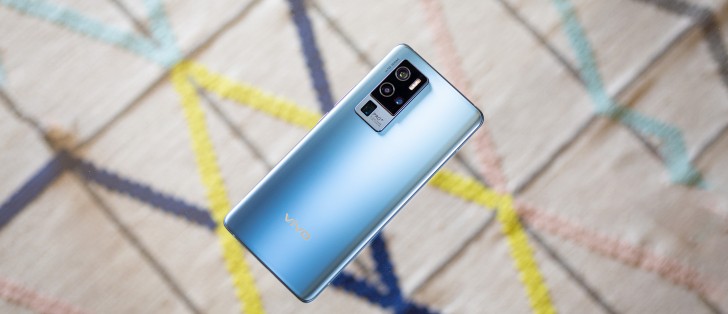vivo X50 Pro+ review

Upgraded quad-camera, no gimbal
The vivo X50 Pro+ features a high-end quad-camera on its back with similar operation logic as the X50 Pro and Huawei P40 Pro, though it lacks the gimbal-stabilization we saw on the regular vivo X50 Pro smartphone.

So, the X50 Pro+ features a 50MP primary shooter, a 32MP portrait one (2x zoom), a 13MP telephoto snapper (5x zoom), and a 13MP ultrawide camera. Laser-assisted autofocus is available, optical image stabilization on 1x and 5x snappers, and there is a triple-LED dual-tone flash.
The main camera is probably the most interesting one. It uses a brand-new 50MP Samsung ISOCELL Plus GN1 1/1.31" sensor (S5KGD1) with a Tetracell color filter, 1.2µm pitch, and f/1.85 24m lens. Laser-assistance and dual-pixel PDAF are available, naturally. Unlike the X50 Pro, the Pro+ offers traditional OIS for the primary camera.
The ultrawide camera uses a 13MP Samsung ISOCELL Slim (S5K3M5) 1/3.4" sensor with 1.0µm pixels and f/2.2 16mm lens. Thanks to the laser-assisted autofocus, you can also shoot macro photos from as close as 2.5cm away from the subject.
Then comes the Portrait camera with a 32MP Samsung ISOCELL Plus GD1 (S5KGD1) 1/2.8" sensor with Tetracell color filter and f/2.1 50mm lens for 2x optical zoom. There is no OIS here, but PDAF is available, of course.
The fourth and final camera on the back is the 13MP shooter with Samsung ISOCELL S5K3L6 1/3.1" sensor with 1.12µm pixels and periscopic f/3.0 128mm lens for 5x optical zoom (well, 5.33x actually). Optical image stabilization and PDAF are both present.

The selfie shooter uses the same 32MP Samsung ISOCELL Plus GD1 sensor with Tetracell color filter behind f/2.45 24mm wide lens. The focus is fixed.

The camera app is the same one we have seen on recent vivos models. You have a zoom selector (0.6x/1x/2x/5x) in the viewfinder and a separate 'lens' selector on the side.






Camera app, settings and modes
The chief modes are switched with side swipes as on most other phones, and the 'More' tab lets you access less common modes. From there, you can also customize the modes you have available in the viewfinder.
Night Mode is available only for the main and ultrawide snappers, and even though it has 2x and 56x toggles as well, those are just digitally zoomed images from the main camera.
There's a Pro mode that lets you tweak photographic parameters yourself. You get to select ISO (50-3200), shutter speed (1/12000s-32s), white balance (presets and a temperature slider), focus distance (no focus peaking), and exposure compensation (-3/+3EV in 1/3EV increments), with easily accessible auto buttons on all and a global 'restore' button to revert everything to auto.
The Pro mode is available on all four cams, you need to use the lens switcher, which in Pro mode offers Super Wide-angle, Medium telephoto, and Telephoto. The 1x switch is not a switch at all, but a zoom slider.




More modes • Pro mode • Pro mode • Supermoon
Photo quality assessment
Let's kick off this chapter with some daylight photos. The pictures we took with the main camera are saved in 4,080 x 3,060 pixels or about 12.5MP, and they are flagship worthy. There is more than enough resolved detail, mostly realistic white balance, commendable dynamic range, and very low noise levels. And the photos are not over-sharpened, which is a rarity these days.
The algorithm may go for warmer than reality color reproduction sometimes, but that's shouldn't be much of an issue - the colors are still pleasantly saturated.
High-resolution option is available, and the dedicated shooting mode snaps photos in full 50MP with the main camera. Since the sensor uses a Tetracell (Quad-Bayer) color filter, the high-res images are upscaled versions of their 12.5MP native output. It's smart upscaling, meaning some interpolation is at play, and the images do look okay, sharp even.
If you downscale the 50MP photos back to 12.5MP you will see they are indeed sharper than the standard pictures, but we can't say they have that much more detail that's going to worth all the hassle and conversions.
The 13MP ultrawide shots are worthy of their name as they are plenty wide, indeed. The resolved detail is average at best, the colors are a bit washed-out, you can see purple fringing quite often, and noise is present here and there.
The dynamic range is very good on the ultrawide shots and the automatic distortion correction does a good job. The photos will do great for social networks but are not on par with the best in the class.
The ultrawide camera can also snap ultra-macro photos from as close as 2.5cm distance. Those have a sharp center and will capture quite detailed ladybug, or flower, or even tiny text on banknotes. The shots are pretty good, and this ultra-macro mode will do for your occasional macro shots you'd like to put on Instagram and the likes.
The 2x zoomed photos from the dedicated portrait camera are saved in 8MP and are excellent across the board. There is a very high level of resolved detail, lovely sharpness, spot-on colors, high dynamic range, and low noise.
There is a high-res 32MP mode available for this camera, and it saves good 32MP images. If you downscaled them to 8MP, you would get a bit higher detail in areas of high complexity. We aren't that picky, and we think the whole procedure isn't worth it, but hey - it's there, and it works.
The portrait camera is, of course, used by the dedicated portrait mode, and the shots are equally stunning. The separation is very proficient, and the blur looks brilliant. We would use this mode quite often for sure.
The 13MP 5x zoomed photos are good, but not quite the best in the class. The detail is enough, sure, but the images are not as sharp as Mi 10 Ultra's or Huawei P40's. Other than that, we are pleased with the color accuracy, the contrast, and the dynamic range.
Now let's look at some night photos. The main camera snaps great pictures that are rich in detail and with well-preserved colors. Their sharpness and contrast are superb, the noise reduction is really smart, leaving just the right level of noise before getting too aggressive and take out some fine detail with it.
The blown highlights are the only imperfection that comes to mind but other than that - these low-light photos are on par with the recent flagships.
The Night Mode is fast and yet proficient enough - it restores the blown highlights, reveals a tiny bit more detail in the shadows, and get rid of the noise we mentioned, though some fine detail goes with it as well.
Note that moving objects such as cars are an enemy to the Night Mode and it may not blur them well.











Main camera, Night Mode, 12.5MP
The 13MP low-light ultrawide photos are okay - the detail is mediocre and smudged at places by the noise reduction, but they keep good contrast and colors. We've seen many worse ultrawide shooters, so while we don't recommend using this one often at night, it may save a good image when the occasion requires it.
And if you want that ultrawide night photo to be brighter, then you should use the Night Mode. It does a good job brightening the images and restores most of the blown highlights.










Ultrawide camera, Night Mode, 13MP
The (2x) portrait camera shoots unexpectedly good photos at night. Sure, the detail is far from spectacular and often smeared by the overly aggressive noise reduction, but they retain rather good colors and contrast. This X50 Pro+ is one of the few phones that uses its 2x tele camera at night, which is nice.
There is no Night Mode for this camera. If you choose 2x in the Night Mode, it will do digital zoom over the main camera.
The vivo X50 Pro+ uses its 5x tele camera at night, too. It snaps soft and noisy images, but you can see what's in there and will do for most occasions that require 5x zoom at night. These aren't as good as what we've seen on the Mi 10 Ultra or the P40 Pro, but good enough for the social networks after a couple of tweaks before posting.
Night Mode doesn't work on this camera either, if you select 5x when in Night Mode, the camera will do 5x digital zoom over the main camera.
Supermoon mode has been a thing for quite a while already and it is present on the vivo X50 Pro+, too. It triggers once you select 10x zoom and improves the texture of the Moon. The first two photos are shot at about 10x, and they are pretty impressive.




Supermoon mode 10x • 10x • 30x • 65x
Once you're done with the real-world samples, head over to our Photo compare tool to see how the X50 Pro+ stacks up against other phones.



vivo X50 Pro+ against the vivo X50 Pro and the Xiaomi Mi 10 Ultra in our Photo compare tool
Selfies
The vivo X50 Pro+ uses a 32MP Quad-Bayer sensor and the phone saves them in 32MP, so the photos can't be sharp. They are still rather nice though with good colors and contrast. We would have been just fine with the processed 8MP stills, too.
You can do selfie portraits, too, and there are tons of beautification options. That's not your thing though show good enough though not and the subject separation isn't always that good. The last photo below is a selfie portrait.
Reader comments
- Anonymous
- 05 Mar 2021
- gBV
I think it could be maybe indeed possible to achieve a slightly(!) higher resolution with Quad Bayer dual pixel sensors than with Quad Bayer sensors (by using a super resolution algorithm), but it seems that Vivo doesn't do that.
- Anonymous
- 19 Feb 2021
- gBV
Samsung, you promised that the GN1 sensor can take 100 megapixel photos, so just a marketing lie?Samsung said "Samsung also provides a software algorithm that takes light information from each photodiode to produce image resolutions comparable t...
- aquinoe
- 04 Feb 2021
- 0p}
Hi. Great camera... but I'm still curious if you can improve photo quality using a Gcam port, specially on ultrawide and telephoto. Has anyone been able to found such a multicamera conscious Gcam?



















































































































